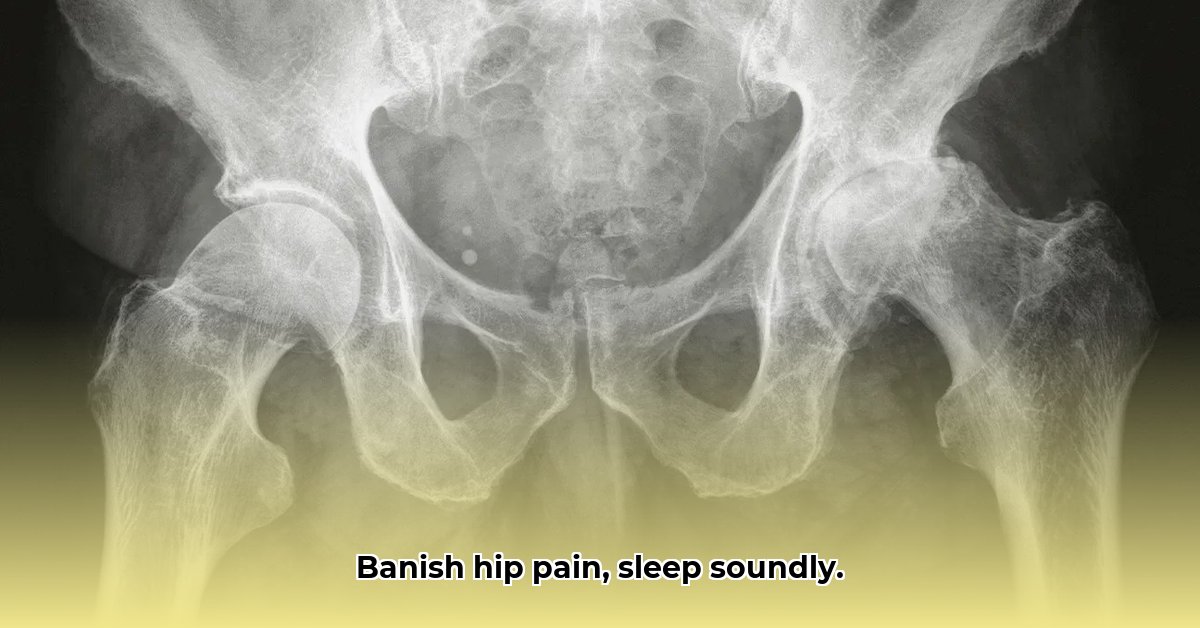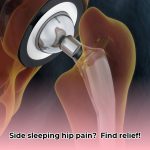That nagging hip pain keeping you up at night? You’re not alone. Many side sleepers experience this, and it can really disrupt your sleep and your day. This guide will walk you through why your hip might hurt when you sleep on your side, and more importantly, show you how to fix it. We’ll cover everything from finding the right pillow and mattress to better sleeping positions, targeted exercises, and simple self-care strategies. Let’s get you sleeping soundly again.
Hip Hurts Sleeping on Side? Find Sweet Relief!
Many of us love to snuggle up on our sides for a good night’s sleep, but that comfy position can sometimes turn into a painful experience if your hips start acting up. Let’s explore why this happens and how you can get back to those peaceful, pain-free nights. Addressing the root cause is crucial for hip pain relief.
Understanding the Causes of Nighttime Hip Discomfort
That nagging hip pain while you’re trying to sleep on your side? It’s often caused by pressure building up in your hip joint and the muscles around it. Imagine your hip and its surrounding muscles as a team. If one part is overworked or stressed, the whole team suffers. This pressure can be especially uncomfortable if you already have conditions like osteoarthritis (joint inflammation from wear and tear), rheumatoid arthritis (an autoimmune disease causing joint inflammation), or bursitis (inflammation of the fluid-filled sacs cushioning the joints). Even poor posture or muscle imbalances during the day can make the problem worse, and your mattress might play a sneaky role too. Pregnancy can also put extra stress on the hips.
The pain itself can range from a mild ache to a sharper, more intense pain—a real sleep disruptor. According to the American Academy of Orthopaedic Surgeons, women are more prone to hip pain than men. Understanding the root cause will help you treat it more effectively. Muscle imbalances, for instance, can stem from prolonged sitting or repetitive movements.
Pillow Power: Your Personal Hip Helpers for Alignment
The good news is we can often tackle this problem with some simple, at-home solutions. Think of pillows as your hip’s personal support system. Strategic pillow placement can really make a difference in distributing pressure and easing discomfort, leading to better sleep hygiene. A well-placed pillow can help achieve spinal alignment and reduce the stress on your hip joints.
Step-by-Step Pillow Placement: Your Nighttime Hip Rescue Plan
- The Knee Gap Guardian: Place a pillow (memory foam or a firm regular pillow works best) between your knees. This isn’t just about comfort; it keeps your hips, pelvis, and spine aligned, reducing strain on your hip joint and preventing painful twisting. Ensure the pillow is thick enough to fully separate your knees.
- The Knee-Support Booster (Optional): A smaller, flatter pillow or a folded towel under your waist can provide even more support, filling the gap between your body and the mattress, especially if you have a wider waist or a softer mattress. Experiment to find what feels best for you; everyone’s body is different.
- The Huggable Helper: Gently hugging a pillow to your chest or stomach can help maintain better alignment throughout your body, preventing your top shoulder from rolling forward and further easing the pressure on your hips. The hug acts like an extra support beam keeping everything in line.
- The Ankle Alignment Assistant: Consider a thin pillow or folded blanket under your ankles to keep your feet elevated and prevent your lower leg from twisting inwards, which can also affect hip alignment. This is particularly helpful if your mattress is very soft.
- The Experimentation Phase: This is crucial. Try different combinations of pillows, different pillow sizes, and pillow firmness to see what offers the most relief. Each person’s body is unique. What works for a friend might not work for you. Don’t be afraid to try body pillows, wedge pillows, or even rolled-up towels to find your perfect support system.
Beyond Pillows: Long-Term Solutions for a Happy Hip and Better Quality Sleep
While pillows can provide immediate relief, addressing the root causes of your hip pain is important for long-term comfort. Some simple lifestyle adjustments can make a big difference in managing pain and achieving restful sleep.
- Weight Management Matters: Carrying extra weight puts added stress on your hips. According to the Arthritis Foundation, every pound of excess weight puts 3-4 pounds of extra pressure on your joints. Even losing a few pounds can ease the pressure considerably.
- Gentle Movement is Key: Regular, low-impact exercise, such as swimming, elliptical training, walking, or cycling, strengthens the muscles supporting your hips, thereby reducing the chances of pain. Avoid high-impact activities like running or jumping that might make the pain worse. The goal is to build strength and flexibility without aggravating your hip.
- Stretching: Your Hip’s Best Friend: Daily stretches that focus on your hip flexors (muscles in front of the hip), glutes (buttock muscles), hamstrings (muscles in the back of the thigh), and piriformis (a deep hip rotator) can significantly improve flexibility and release tight muscles. These simple stretches can prevent stiffness and pain before it even starts. Hold each stretch for at least 30 seconds.
- Posture Check-Up: Throughout the day, pay attention to your posture. Slouching can lead to misalignment in your hips, contributing to pain. Try to maintain good posture as much as you can. Use ergonomic chairs and supportive cushions when sitting for long periods.
- Warm Baths & Topical Treatments: A warm bath with Epsom salts before bed can relax muscles and ease pain. Topical creams containing menthol or capsaicin can also provide temporary relief.
- Anti-Inflammatory Diet: Incorporate foods with anti-inflammatory properties into your diet, such as fatty fish (salmon, tuna), nuts, seeds, olive oil, and colorful fruits and vegetables. Limit processed foods, sugary drinks, and red meat, which can contribute to inflammation.
When to Call in the Pros: Know Your Limits For Hip Pain
While home remedies can provide temporary relief, persistent or worsening pain needs a professional evaluation. It’s always best to consult your doctor or physical therapist if:
- Pain Persists: The pain continues despite trying the home remedies mentioned above for several weeks.
- Severe Pain or Interference with Daily Life: The pain is intense, sharp or significantly hampers your day-to-day activities, such as walking, climbing stairs, or sleeping.
- Other Symptoms Appear: You notice swelling, redness, warmth, numbness, tingling, or fever around your hip.
- Limited Range of Motion: You have difficulty moving your hip or leg.
- Clicking or Popping: You experience clicking or popping sensations in your hip joint.
Targeted Exercises: A Physical Therapist’s Expertise for Hip Mobility
A physical therapist can tailor an exercise plan for your specific needs, focusing on strengthening, stretching, and improving hip mobility. These targeted exercises might include:
- Hip Flexor Stretch (Kneeling): Kneel on one knee with the other foot forward, gently pushing your hips forward until you feel a stretch in the front of your hip.
- Glute Bridges: Lie on your back with your knees bent and feet flat on the floor. Lift your hips off the floor, squeezing your glutes at the top.
- Clamshells: Lie on your side with your knees bent and feet stacked. Keeping your feet together, lift your top knee up, engaging your glutes.
- Piriformis Stretch (Figure Four): Lie on your back with your knees bent. Cross one ankle over the opposite knee and gently pull the uncrossed thigh towards your chest until you feel a stretch in your buttock.
- Hip Abduction: Stand with your feet hip-width apart and slowly lift one leg out to the side, keeping your core engaged.
- Hip Strengthening Exercises: Exercises that strengthen the muscles supporting your hip for added stability and support. Examples include side leg raises, glute bridges, and squats.
- Core Strengthening Exercises: A strong core is essential for maintaining good posture and reducing stress on your hips. Think of your core as the foundation of proper body alignment; strengthening it helps prevent hip misalignment. Planks, bird-dogs, and dead bugs are all effective core exercises.
Important Note: Always consult your doctor or physical therapist before starting any new exercise routine.
Mattress Matters: Your Sleep Sanctuary for Spinal Alignment
Your mattress plays a crucial role in your comfort. A mattress that supports your body properly can be a game changer. A medium-firm mattress is generally recommended for people who often experience hip pain; it offers a good balance of support and comfort. Look for mattresses that contour to your body while providing adequate support for spinal alignment. Memory foam or latex mattresses are often good choices.
If your mattress is too firm, consider adding a memory foam topper to provide more cushioning. If your mattress is too soft, a firmer mattress topper or even a board placed under the mattress can add support.
Consider a sleep number mattress, which allows you to adjust the firmness on each side of the bed.
Other Considerations for Optimal Sleep
- Sleep Position: While side sleeping is common, experiment with sleeping on your back with a pillow under your knees to see if that relieves pressure on your hips.
- Sleep Hygiene: Maintain a regular sleep schedule, create a relaxing bedtime routine, and ensure your bedroom is dark, quiet, and cool.
- **Assistive Devices
- Unlock Young Doctors’ Work-Life Balance: Actionable Strategies Now - December 2, 2025
- Unlock Life Harmony: Work-Life Integration Guide - November 30, 2025
- Unlock Work-Life Harmony:Your Guide to Integration - November 27, 2025
















